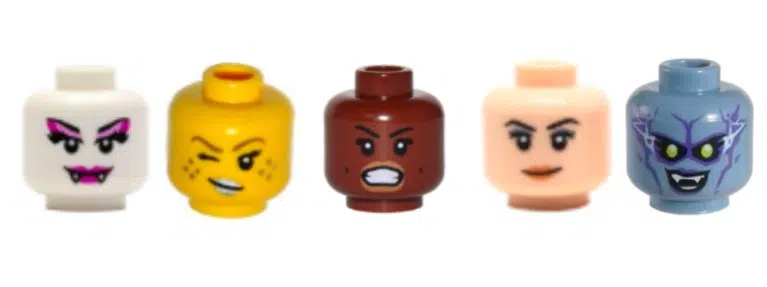
Female minifigure heads differ from their male counterparts in many ways. First, almost all female minifigure faces wear makeup, and a large fraction have smirking, even provocative expressions that are not seen in male heads. Our analysis explored all 525 female heads produced by LEGO and reveals what expressions are most common on female minifigure heads.
Female Minifigure Heads
LEGO was once exclusively marketed towards boys, and especially white boys. Although The LEGO Group have since diversified their targeted audience, gender and racial bias are still rampant in their products. This discrepancy is best seen in the production of their minifigures, which make up the LEGO community.
Facial features are key to understanding bias in LEGO minifigs. Facial expressions tell us about what biases are present in how women and women of color are depicted as LEGO toys, and features such as makeup and glasses inform us about how women are being represented in the LEGO community. To explore this concept further, we did a deep dive into all the female LEGO minifigure heads ever released to explore the expressions and facial features of the female LEGO population and break down the bias present in LEGO minifigures.
The Data
We collected minifigure head data from Bricklink on May 30th, 2020 (so our analysis does not include June 2020 releases) and in solid colors only – no translucent, pearl, metallic, etc. shades. The chart below shows the total number of heads vs. total number of female heads released each year since 1978, when the first minifigure was produced, until May 30th, 2020.
Expression Breakdown
We analyzed every female minifigure head to determine which facial expressions were present on each one. Please note that since many of the heads have dual faces and may have more than one expression on their faces, there are more than 525 expressions on 525 heads.
Please also note: in our analysis, happy expressions refer to a genuinely pleased expression in addition to a smile, while smiling faces are defined as simply having mouths that are turned upward and may not necessarily have happy expressions (ie. they might be neutral, smirking in a determined way, etc.). A beauty mark refers to any mark on the head that is not face paint including: freckles, moles, dimples, wrinkles, crow’s feet, etc. In addition, the following graphs only include unmodified, solid color heads.
The following graph reveals the number of instances common facial expressions showed up on the 525 female minifigure heads produced by LEGO.
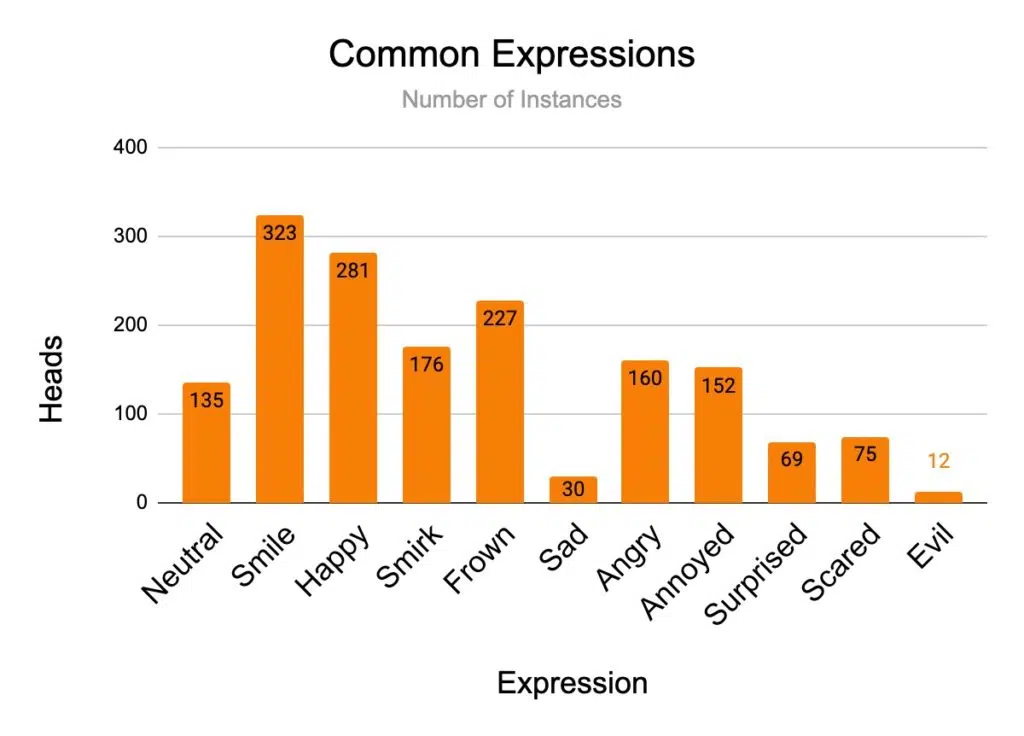
The next chart shows some of the 3 more distinct expressions on female minifigures over time — happy, angry and sad. Happy faces are almost always more common, but we also see that angry expressions are usually present in more than half of all released female heads.
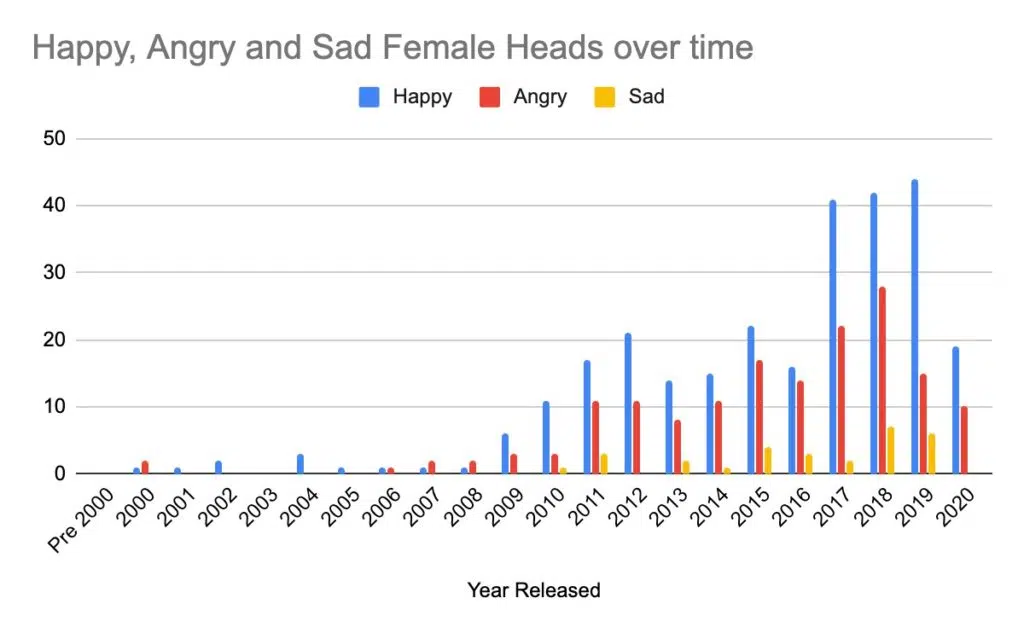
This next graph shows the instances of smirking, frowning and smiling female heads released over the years. Again, smiling heads seemed to be most common, but smirking and frowning expressions were not far behind and were usually present in a majority of female heads.
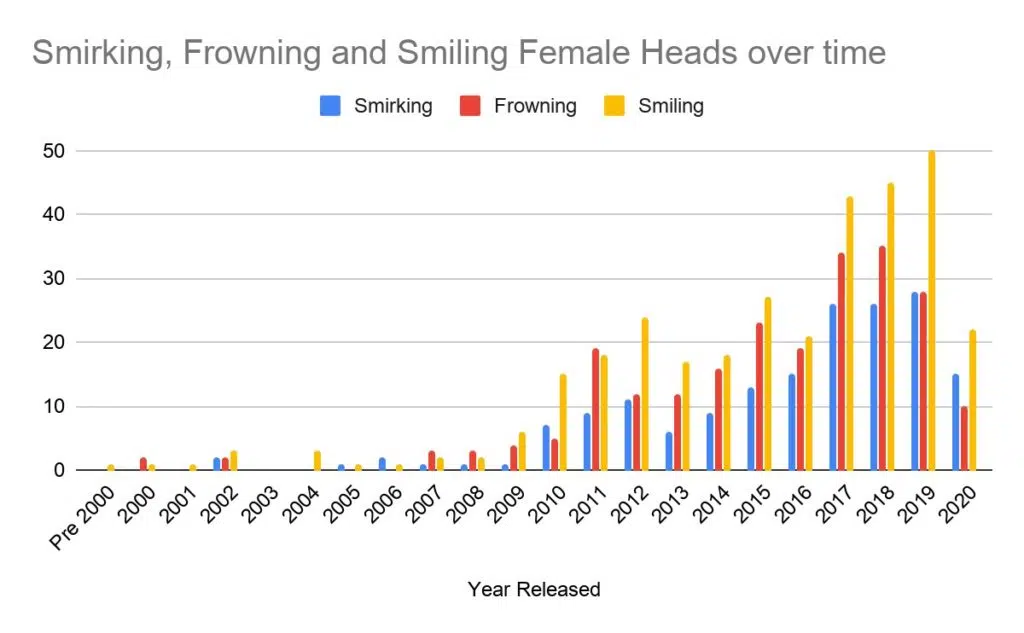
We also wanted to look into the distribution of expressions depending on head color. As shown in the following chart, there is a far larger percentage of angry faces (negative expression) in the reddish brown and medium nougat colors, which represent people of color (POC), than in the yellow or light nougat colors, which represent white people.
There is also a greater percentage of annoyed and frowning faces (negative) in the reddish brown and medium nougat colors than in yellow or light nougat colors. Meanwhile, there is a larger percentage of smiling faces (positive expression) in the yellow and light nougat colors than in reddish brown and medium nougat. Happy expressions (positive) are about even across yellow, light nougat and medium nougat, but there is a significant lack of happy expressions in the reddish brown color.
The discrepancy between positive facial expressions in POC-coded faces when compared to white-coded faces perpetuates harmful racial stereotypes and continues to equate darker skin colors with negativity. Because there are so few reddish brown and medium nougat heads, the small sample size plays a role in the differences in percentage. This nevertheless underscores the underlying problem: there are not enough heads depicting people of color.
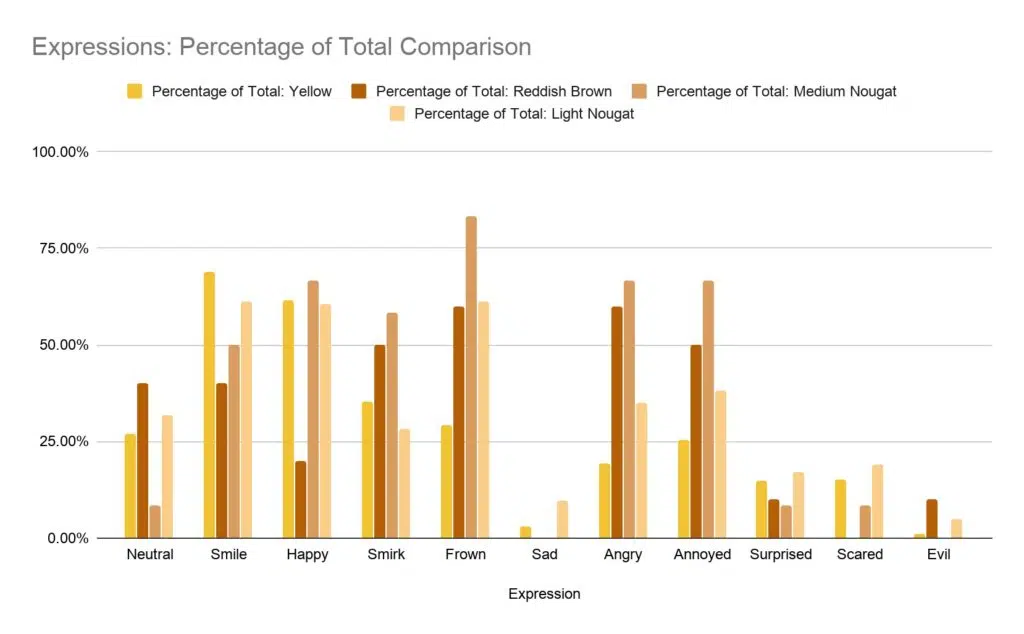
Smirking Faces
One expression we were most interested in investigating in female heads was the smirk. Smirking was one of the most common female minifigure head expressions, and we had noticed that these smirks sometimes carried provocative or sexualized expressions. We categorized the smirking heads into 5 categories as shown below.
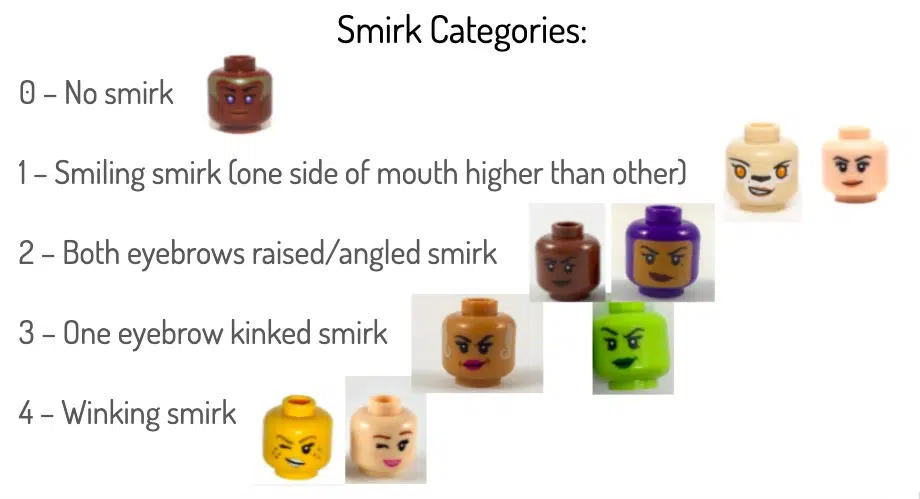
The results of our analysis of female smirking faces can be found in the chart below. A large majority of female smirking faces had smirking expressions with eyebrows raised or winking, which in some cases can be perceived as being provocative or sexualized. This is not the case with nearly all of the male minifig faces.
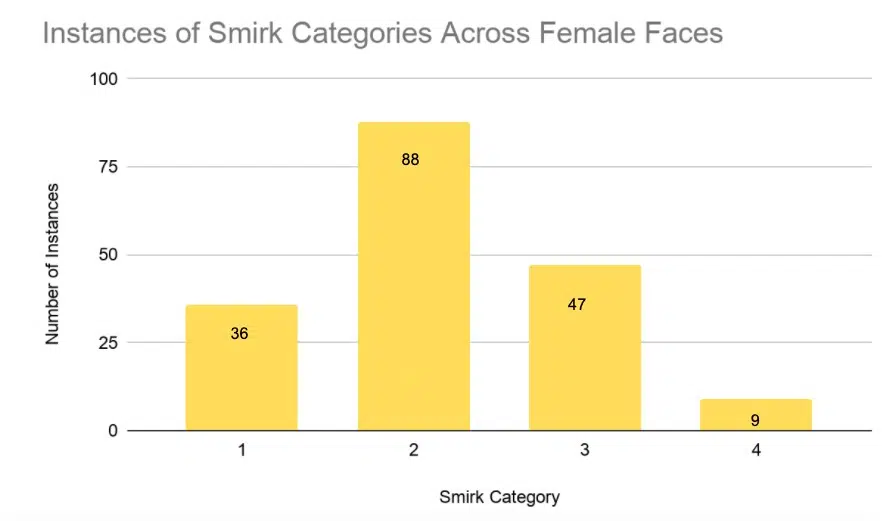
Other Characteristics
In addition to expressions, we looked at features such as makeup and beauty marks. Makeup especially is one of the defining characteristics LEGO uses to distinguish male from female heads. It follows that we found an overwhelming amount of makeup use on female heads. Only 6% of female heads had no distinct makeup (lipstick, eye shadow, etc.) on their faces. The female heads were ranked on a scale from 0-4, with Level 0 representing no makeup and 4 representing full face makeup, as shown below.
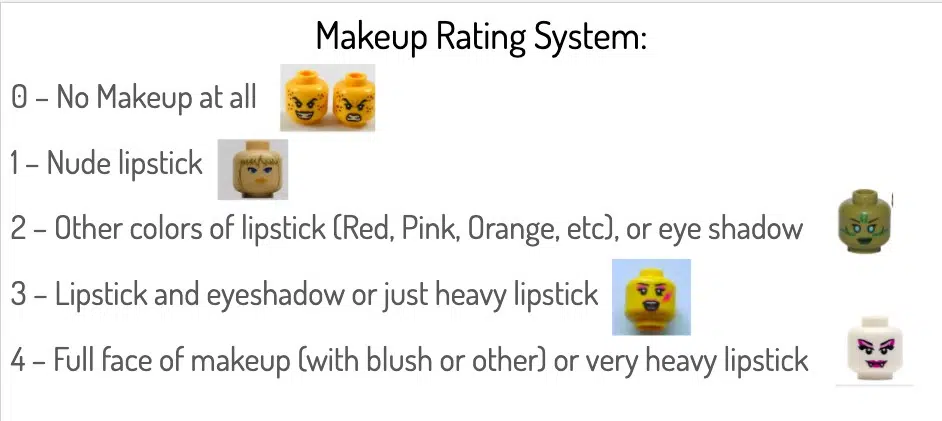
The results of our minifig makeup analysis are shown in the following chart:
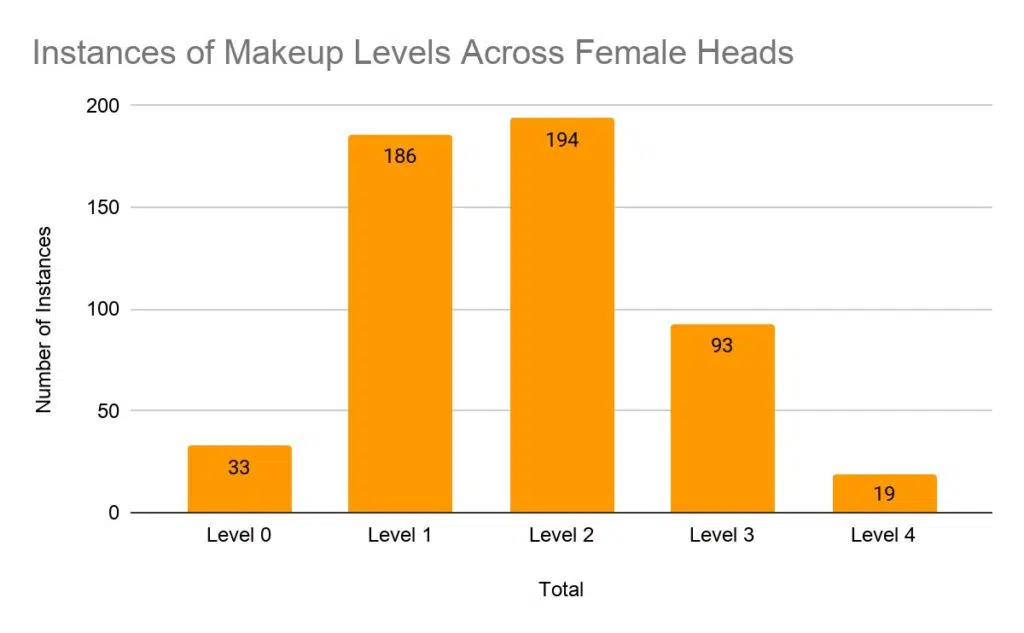
This following graph shows the presence of beauty marks and glasses on female faces over time. It seems that between one third to one half of female heads produced each year have beauty marks, but much fewer have glasses, with a maximum of 11 released in 2018 (about 15%). Because around 50% of women wear glasses regularly, it is important to see how glasses-wearing is represented in LEGO products.
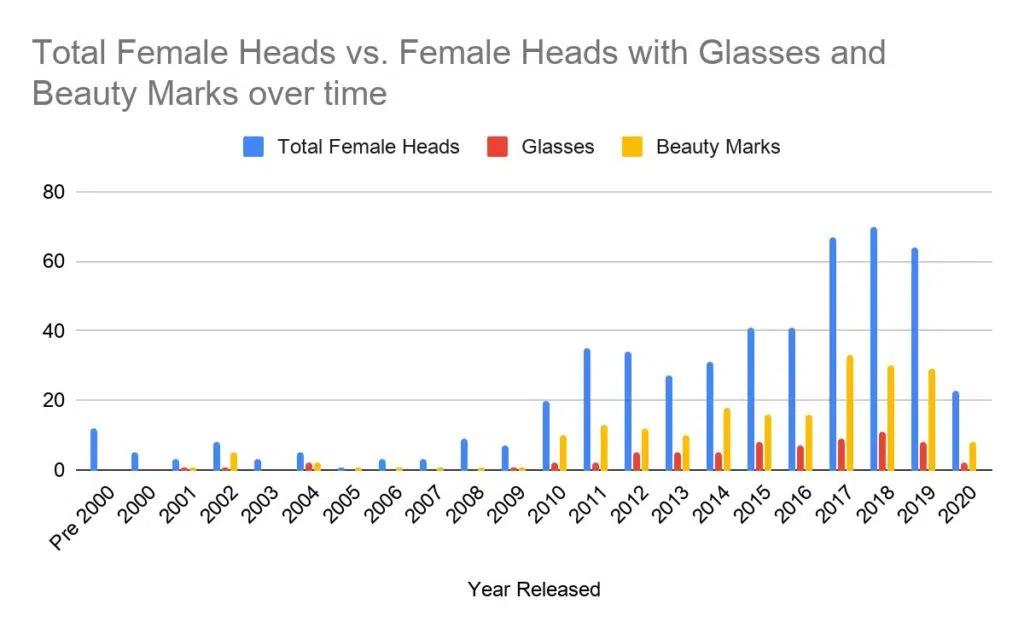
Conclusions
During this deep dive, we gathered a wealth of information about biases present in how women and women of color are represented in the LEGO community. Here are a few key takeaways from our analysis:
- When people of color are represented as LEGO heads, they are far more frequently depicted with negative expressions, such as frowning or angry, than their white-coded counterparts.
- Smirks are one of the most common female minifig expressions, and many of female smirking faces had smirking expressions which can be perceived as being provocative or sexualized.
- 94% of female minifig heads wore makeup, and only 13% wore glasses.
With these issues in mind, we have a few recommendations for The LEGO Group to make their minifigure populations more reflective of our real-world communities.
- Pay attention to the facial expressions on minifigure heads coded as people of color to ensure that they do not show negative facial expressions at a greater frequency as white-coded heads.
- Reduce the number of smirking faces on female heads, and be careful not to produce provocative or sexualized female facial expressions.
- Reduce the number of female heads with makeup and produce more faces wearing glasses to be more reflective of our real community.
There are a lot of steps LEGO still needs to take before we come close to having a representative selection of minifigures that reflect the true world population. Through our breakdown of female minifigure expressions, we have learned about what issues are present in the current minifigure population and where adjustments need to be introduced to make the LEGO community reflective of the real world.
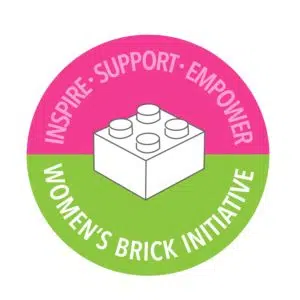

1 comment
Jared
I’d be curious to see how this has changed in the last three years since this article was posted. I suspect the outlook for diverse and realistic feminine representation is better in 2023 than it was in 2020. Can’t wait for the next article on the subject! 😉